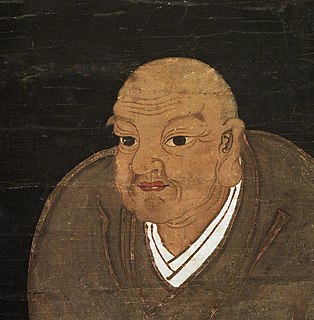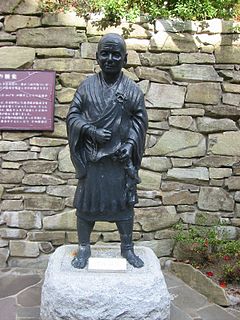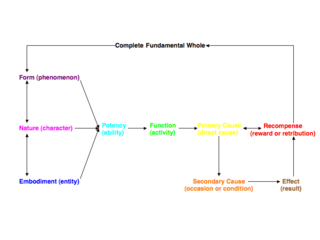Notes
- ↑ The Soka Gakkai Dictionary of Buddhism (2002). Chitatsu. Source: Archived 2011-06-06 at the Wayback Machine (accessed: January 7, 2008)
Chidatsu (c653) was a priest of the Hosso School of Japanese Buddhism.
Chitatsu / Chidatsu (智達)
The Soka Gakkai Dictionary of Buddhism (2002) mentions Hsyan-tsang, Tz'u-en, Dosho of Gango-ji, Nara, Gango-ji, Chitsuare in reference to elucidating that Chitatsu was:
A priest of the Dharma Characteristics (Hosso) school in Japan. In 658, together with Chitsu, he journeyed to China and studied the doctrine of the Dharma Characteristics school under Hsyan-tsang and his disciple Tz'u-en. They brought the doctrine back with them. Earlier, Dōshō of Gangō-ji temple in Nara went to China in 653 and studied under Hsyan-tsang. On his return he spread the Dharma Characteristics teaching at Gango-ji. Thus Chitatsu and Chitsuare regarded together as the second to propagate the doctrine of this school in Japan. After his return, Chitatsu lived at Gango-ji temple and disseminated the Dharma Characteristics doctrine. [1]

Nichiren was a Japanese Buddhist priest and philosopher of the Kamakura period.

Nichiren Buddhism is a branch of Mahayana Buddhism based on the teachings of the 13th-century Japanese Buddhist priest Nichiren (1222–1282) and is one of the Kamakura Buddhism schools. Its teachings derive from some 300–400 extant letters and treatises either authored by or attributed to Nichiren.

Nichiren Shōshū is a branch of Nichiren Buddhism based on the teachings of the 13th-century Japanese Buddhist priest Nichiren (1222–1282), claiming him as its founder through his senior disciple Nikko Shonin (1246–1333), the founder of Head Temple Taiseki-ji, near Mount Fuji. The lay adherents of the sect are called Hokkeko members. The Enichizan Myohoji Temple in Los Angeles, California serves as the temple headquarters within the United States.

Soka Gakkai is a Japanese Buddhist religious movement based on the teachings of the 13th-century Japanese priest Nichiren as taught by its first three presidents Tsunesaburō Makiguchi, Jōsei Toda and Daisaku Ikeda. It is the largest of the Japanese new religions and claims the largest membership among Nichiren Buddhist groups. “The organization bases its teachings on Nichiren's interpretation of the Lotus Sutra and places chanting "Nam Myōhō Renge Kyō" at the center of devotional practice. The organization promotes its goals as supporting "peace, culture, and education".

Tendai is a Mahayana Buddhist school established in Japan in the year 806 by the monk named Saichō, posthumously known as Dengyō Daishi. The Tendai school rose to prominence during the Heian period (794-1185), gradually eclipsing the powerful Yogācāra school (Hossō-shū) and competing with the upcoming Shingon Buddhism to become the most influential at the Imperial court.

East Asian Yogācāra refers to the traditions in East Asia which represent the Yogacara system of thought.

Buddhism has been practiced in Japan since about the sixth century CE. Japanese Buddhism(Nihon Bukkyō) has given birth to numerous new Buddhist schools, many of which trace themselves to Chinese Buddhist traditions. Japanese Buddhism has had a major influence on Japanese society and culture and remains an influential aspect to this day.

Nichiren Shū is a combination of several schools ranging from four of the original Nichiren Buddhist schools that date back to Nichiren's original disciples, and part of the fifth:

Saichō was a Japanese Buddhist monk credited with founding the Tendai school of Buddhism based on the Chinese Tiantai school he was exposed to during his trip to Tang China beginning in 804. He founded the temple and headquarters of Tendai at Enryaku-ji on Mount Hiei near Kyoto. He is also said to have been the first to bring tea to Japan. After his death, he was awarded the posthumous title of Dengyō Daishi (伝教大師).

Tahō Fuji Dai—Nichi–Renge—zan Taiseki-ji; more commonly just Sōhonzan Taiseki-ji (総本山大石寺), informally known as Head Temple Taiseki-ji (大石寺) is the administrative center of Nichiren Shoshu Buddhism. It is located in the foothills of Mount Fuji in Kamijo, Fujinomiya, Shizuoka Prefecture, Japan. Taiseki-ji was founded in 1290 by Nikkō Shōnin, one of Nichiren's senior disciples, on a land parcel donated by the believer Daigyo Sonrei, commonly known as Nanjo Tokimitsu (1259—1332).
Nikken Abe was a Japanese Buddhist monk who served as the 67th High Priest of Nichiren Shōshū Buddhism and chief priest of Taiseki-ji head Temple in Fujinomiya, Japan.

Gyōki was a Japanese Buddhist priest of the Nara period, born in Ōtori county, Kawachi Province, the son of Koshi no Saichi. According to one theory, he was of Korean descent.
Hyegwan (Japanese: Ekan was a priest who came across the sea from Goguryeo to Japan in the Asuka period. He is known for introducing the Chinese Buddhist school of Sanlun to Japan.
Chitsū (智通) was a priest of the Hosso School of Japanese Buddhism.
Tokuitsu (徳一) (781?-842?) was a scholar-monk of the Hossō sect of Buddhism in Japan. He is best known for his debates with other leading Buddhists of the time, Kūkai and Saichō, and for asserting a more orthodox view of Mahayana Buddhism based on the state-sanctioned schools of Nara, Japan.

The Ten suchnesses are a Mahayana doctrine which is important, as well as unique, to that of the Tiantai (Tendai) and Nichiren Buddhist schools of thought. The doctrine is derived from a passage found within the second chapter of Kumarajiva's Chinese translation of the Lotus Sutra, that "characterizes the ultimate reality of all dharmas in terms of ten suchnesses." This concept is also known as the ten reality aspects, ten factors of life, or the Reality of all Existence.
Viśiṣṭacāritra is a bodhisattva mentioned in the 15th, 21st, and 22nd chapters of the Lotus Sutra. He is one of the four great perfected bodhisattvas who attends Gautama Buddha and protects the Lotus Sutra and its devotees. The other three are Anantacaritra, Visuddhacaritra, and Supratisthitacaritra; together they make up the four great primarily evolved bodhisattvas. Viśiṣṭacāritra is also believed to represent the "true self" characteristic of buddhahood, which is the selflessness of Nirvana.
Dōshō was a Japanese monk credited with playing an influential role in the founding of Buddhism in Japan. In C.E. 653, he travelled to China, studying under the Buddhist monk Xuanzang, whose travels to India were immortalized in the book Journey to the West. His studies centered on Xuanzang's Weishi, Chinese variant of Indian Yogācāra, but he was also exposed to Chinese Chán while there, which would later lead to his influence on the founding of Japanese Zen Buddhism. In China, the school is known as Wéishí-zōng, or Fǎxiàng-zōng. In Japan, it is known as Hossō-shū (法相宗) or Yuishiki-shū (唯識宗).
The Six Schools of Nara Buddhism, also known as the Rokushū 六宗, were academic Buddhist sects. These schools came to Japan from Korea and China during the late 6th and early 7th centuries. All of these schools were controlled by the newly formed Japanese government of Nara. These schools were installed to mimic and expand upon already existing mainland Asian Buddhist thought.

Fuji Taiseki-ji Kenshōkai (冨士大石寺顕正会) is a Japanese Nichiren Buddhist religious lay group. Kenshōkai was founded as a lay group affiliated with Nichiren Shōshū in 1942 in the Myokoji Temple in Shinagawa ward in Tokyo, and was originally called Myōshinkō (妙信講). After engaging in conflict with fellow Hokkeko members, it transferred to Myoenji Temple in Sumida, Tokyo. It upholds the Taiseki-ji Head Temple to possess the true Dai Gohonzon of Nichiren, although it does not itself control Taiseki-ji. Its headquarters are located in Junō-chō, Ōmiya-ku, Saitama Prefecture. After the demise of 67th High Priest Nikken Abe in 2019, its senior adherents have been widely permitted to enter the “Gokaihi” audiences at the Dai Gohonzon more often under an oath of anonymity and discretion.